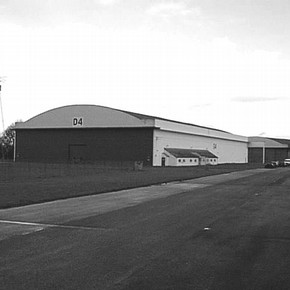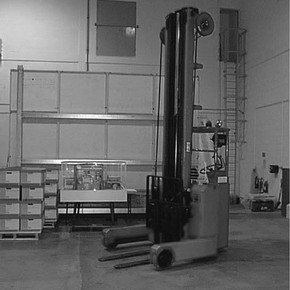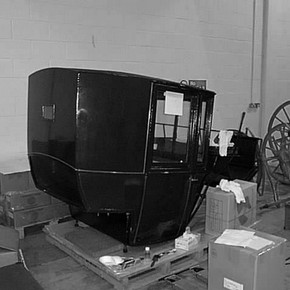Conservation Journal
Spring 2001 Issue 37
Management of Large Objects at the Science Museum, Wroughton
Introduction
Wroughton airfield, near Swindon, is one of two stores owned by the Science Museum and is used for the storage of the Museum's collection of large objects. The site currently stores around 20,000 objects in seven hangars and a modern purpose-built store.
The site was originally a wartime, RAF airfield. The Science Museum first occupied the site at the end of 1979 when they took over 6 hangars. By the middle of the 1970's the Science Museum was looking for suitable new premises for storage and display. The Museum had been collecting historic aircraft since 1912 and a site was needed to allow for the extension of the existing collection in London, in particular to allow for the acquisition of large civil aircraft. Wroughton Airfield was seen as fulfilling that need and was formally taken over on 1st May 1980. The first aircraft of the new commercial air transport collection - a 1936 Douglas DC3 and a 1960 De Havilland Comet 4B- arrived during 1979.
The Wroughton site had other benefits for the Science Museum. It allowed for the further development of the Road Transport Collection, which was necessary when objects from the Museum of Transport in Clapham were passed over to the Museum: in particular the commercial road vehicles. The site was also necessary to enable the comprehensive development of the Science Museum's collection of agricultural machinery. Of course, the site offered extra space for the storage of many other areas of the Museum's collections and especially those larger objects.
The site - storage and handling
Today, the Science Museum owns ten hangars, having recently increased its holding by three, on a site of some 600 acres. The hangars vary in construction: there are four of the 'L' type 'Blister' hangars (a steel framework with a concrete skin), four of the 'D' type hangars (steel reinforced concrete with an arching roof and windows), and two 'C' type hangar (steel framework with a wooden roof). The majority of the large objects in the collections are housed in the 'L' and 'D' hangars, with the 'C' hangar being used primarily for conservation and overflow storage. At present, the three new hangars (two 'D' and one 'C' type) remain empty awaiting funding to refurbish them for museum use.
In 1994 the Museum opened a new purpose-built storage building at Wroughton. It was designed to the Museum's specification with some consideration being given to conservation requirements. Known as A1 Store, it was built to house objects previously stored in an old warehouse in Hayes, West London. A1 provides an environmentally controlled envelope with racking used to make maximum use of the space available. Objects are stored on pallets on fixed or mobile racking units and accessed by forklift trucks. In this way, the building is able to hold over 10,000 objects.
The objects at Wroughton range in size from civil airliners like the De Havilland Comet 4B to bicycles and refrigeration units from industrial cold stores to domestic fridges. The day-to-day management of the collections is the responsibility of the site curator and his team of four stores officers. They make decisions as to the most suitable location for the storage of individual objects in discussion with the conservation staff on site. There are really three categories of storage on site:
-
'display' storage
-
'deep' storage
-
closely controlled environmental storage
Of the five hangars, three are used for display of objects, the majority of which relate to transportation. One displays the majority of the aircraft along with a number of aero-engines. A large proportion of this hangar is left open to allow for corporate hire by the Museum: a source of much needed income. The second hangar houses a more mixed collection, including the bulk of the Museum's aero-engines, and the fire fighting collection. The third displays most of the Science Museum's road transport collection and its agricultural collections. Two of the remaining hangars are used for the deep storage of collections, which vary enormously from a massive ammonia compressor to a wooden hearse. A1 Store is the repository for all of the Museum's more sensitive objects.
The objects are either held on wooden pallets stored on racking or stand on the floor, or because of their size or weight, stand directly on the hangar floor. Objects are moved in a variety of ways, the palletised ones being the easiest to deal with. The stores' staff is all trained in the operation of forklift trucks of several types, as these are the main tools used for the safe movement of our objects. Pallet trucks are also very useful. For larger and more awkward objects, a variety of pieces of equipment can be employed, and again, the staff is trained in their use.
A lot of the larger pieces are moved with a 10 ton forklift truck, while the aircraft are moved on their wheels (once tyres have been safely inflated) using a special towing tractor. These operations happen very rarely and need careful planning. Many of the large vehicles are moved under their own power, as this is the safest and easiest method. Conservation staff assists with these larger moves and helps monitoring the object to minimise the risk of damage. Only the largest and most awkward of objects require specialist assistance from outside companies (e.g. railway locomotives, printing presses and very heavy engineering pieces).
Care and conservation
There is a small, dedicated team, of five conservation staff at Wroughton whose job it is to look after the collections. They have a very varied role and have to be flexible, team players. Apart from the conservation of objects for Museum exhibitions and loans, one of the team's primary roles is the care and maintenance of the collections.
The Museum's aim is to gradually improve the overall condition of all the objects stored at Wroughton and this is achieved in a number of ways:
-
The conservation staff attempt to clean all the objects in the display hangars on an annual basis. Aircraft present the greatest problem due to their sheer size and issues of safe working. Scaffold towers and mobile platforms are used to give access to the fuselage and upper wing areas. A mixture of dry and controlled wet treatments is used for cleaning.
-
Site staff normally checks any object arriving at Wroughton before it is dispatched to its storage location. If a problem is identified, the conservation staff is called in to deal with it. This may simply be the draining of vehicle fluids, the removal of batteries or the surface cleaning of objects. They will also check for pest infestations and carry out any repair work.
-
A lot of staff time is spent on preventive conservation. This includes improvements to the storage of individual objects. Recently, each bicycle in the collection has had its own stand made. This supports the cycles and lifts them off their tyres. Many of the vehicles have been placed on axle stands in order to take the weight off their tyres, wheel bearings and suspension components. There is currently a programme in place to cover our aero-engines, as their annual cleaning is a very time consuming process. A specialist company has been employed to make tailored covers for each engine out of a high quality material used for the manufacture of marquees.
-
The only form of environmental control is heating. Whilst the rate of deterioration of the collections in store is negligible, conservation staff apply protective coatings to vulnerable surfaces, particularly metals, as a precaution. High quality, inhibiting wax coatings are used. These were originally designed for use by the aviation industry and the military.
-
Condition checks are carried out on all new acquisitions, and on any objects leaving site for loan or returning from loan. Staff is beginning to look at carrying out detailed condition surveys of the collections. It is hoped to undertake a major survey of the structure and condition of all the aircraft in the collections during 2001. This will need input from specialist aircraft engineers as each is made up of a surprising number of components.
-
Many of the objects in the Museum's collections present some form of health and safety hazard. It may be their sheer size or weight. Others have particular hazards: radioactivity, chemical residues, asbestos, and need to be specially stored. These are dealt with on site where possible but usually the Museum takes advice from the appropriate specialists.
The Science Museum has established an efficient and well-tried system for the proper management and care of its collection of large objects and this has enabled us to maximise the store use.
Spring 2001 Issue 37
- Editorial - Size Matters
- The Treatment of Mail on an Arm Guard from the Armoury of the Shah Shuja: Ethical Repair and in situ Documentation in Miniature
- Management of Large Objects at the Science Museum, Wroughton
- Digital Weightlifing and the Conservation of Large, Heavy Objects
- Four Terabytes and Counting
- Colour Changes for the V&A Facade
- Review of 'Gilding: Approaches to Treatment' UKIC Gilding Section Conference


